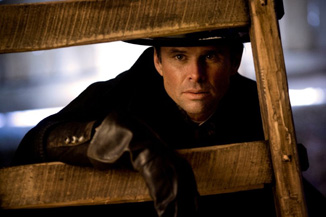Movie Review: The Hateful Eight
By Ben Gruchow
January 5, 2016
BoxOfficeProphets.com

Still, it’s one thing to conceptualize a movie about the bad guys, and another to spend 167 minutes with them, even if those 167 minutes are spent in the context of some of the most gorgeous and expansive 70mm cinematography you could ask for. Why Tarantino went for such a gigantic resolution in a movie that largely takes place on a single set (and not a big one), I don’t know; I feel safe in knowing that it’s better to be given a beautiful film without understanding why than to be given a version of The Hateful Eight that was shot on HD video because it’d be cheaper. Tarantino has always been a visual filmmaker, and just about every frame of this effort pops.
One of the movie’s best images is also one of its first: Samuel L. Jackson, sitting atop a pile of frozen bodies, waiting in the middle of a road as a stagecoach approaches. There’s a storm approaching, and when the stagecoach stops, Tarantino gives us a closeup on Jackson’s weathered face as he lifts his head to take notice. It has been a long, long time since photography this detailed, this evocative and atmospheric, has been put in the service of a storyteller that’s as visually bold as Tarantino is. Other moments in the film have a similar impact; most of the action takes place in a combination bar and inn called Minnie’s Haberdashery during a furious blizzard, and in the few wide shots we’re given when the action moves outside, the sense of depth and scope is startling.
The story that takes place within these visuals is incongruously small and intimate. And mean-spirited, kind of, which is honestly pretty new in this director’s lexicon. The eight travelers snowbound in Minnie’s Haberdashery all have some kind of secret they’re concealing, to varying degrees. As the movie winds on and things get progressively consequential, we start to see the weather and its severity in a deterministic way. Our characters are here because they must be here, because it’s the only way their individual stories can come to any kind of conclusion. Tarantino has never been a filmmaker inclined to give his characters much in the way of free will, and the arrangement of the unfolding story in The Hateful Eight is immediately comprehensible as a series of pieces being moved around a board, into and out of position, by someone out of sight.
It may be this that contributes to the movie leaving me comparatively cool - not the simple impression of a puppet master moving his subjects on strings, but the feeling that that’s all there is here. For a feature that runs precariously close to three hours, The Hateful Eight leaves us with awfully little to go on by its end. The story construction plays out like most of Tarantino’s latter work, in more or less linear chapters, but the technique plays itself out well before the final scenes do, and it isn’t long before we anticipate a chapter that will explain everything by taking us backward through time, prior to the start of the movie.
We’re introduced to the eight core characters piecemeal: the movie starts with Jackson as Major Warren, a bounty hunter transporting that pile of bodies to Red Rock, Wyoming, for payment. In the stagecoach is another bounty hunter, John Ruth (Kurt Russell, barely recognizable behind an avalanche of facial hair). John’s charge is Daisy Domergue (Jennifer Jason Leigh), a wanted fugitive. In advance of the encroaching blizzard, and with some reluctance, Ruth allows Warren to hitch a ride with the two of them. Soon enough, they’ve picked up another traveler: the soon-to-be sheriff of Red Rock - and the one in the position to pay the two bounty hunters for their corpses - Chris Mannix, played by Walton Goggins. It’s not until the four land at the Haberdashery that we meet the remainder of the Eight, and I will leave the remaining identities for you to discover.
It’s all well and good for a story to lack a protagonist, or even a likable figure, provided that the main character or characters are drawn with clarity and the right broad strokes. We don’t get that here, and I blame the introductions stacking on top of each other is to blame; the first two long scenes - consisting of Russell, Jackson, and Leigh - are engaging and intriguing passages. We are waiting for their characterizations to deepen. Then Mannix joins, and the expected character elaboration arrives at the hands of a character we don’t know much of and have little reason to believe. This does not happen just once.
To a degree, I understand this is the point. The entire affair is about peeling back layers of deception, with participants that would form a decent antagonist in any other Tarantino film. And each individual gets a moment of dialogue and motivation. We are not meant to identify with anyone; we’re meant to look down on the scene along with the puppet-master, enjoying the mystery while being unable to invest in anyone. Picture two hours of Bill’s comic-book speech from Kill Bill, Vol. 2, multiplied. We lack an anchoring figure like the Bride, or Christoph Waltz’s Dr. Schultz from 2012’s Django Unchained.
The movie is well-paced and colorful in its approach, even if there’s not a lot to hang onto by the end. There’s little of the pokeyness that sporadically invaded the beginning and middle passages of Unchained. And when the lightweight storytelling gets to be too much, there’s always the scenery to fall back on. A step back for Tarantino is still many steps ahead of most other entries in the cinematic subgenre he helped to create. It’s a film that I can recognize the aim of, as well as the merits inherent, even if I don’t actually end up liking it all that much.